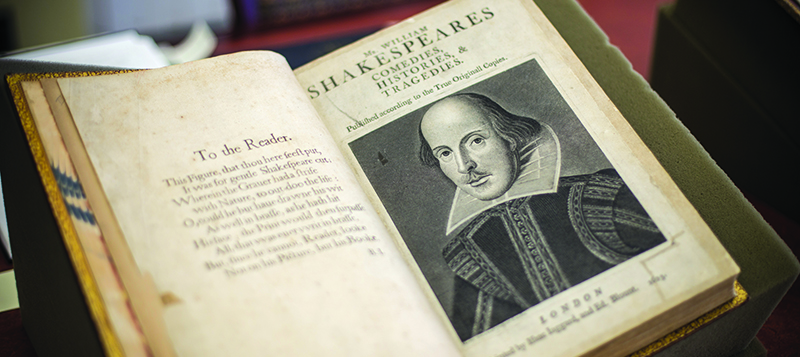
Up Close and Personal with William Shakespeare’s First Folio
Published in 1623, seven years after Shakespeare’s death, Mr. William Shakespeare's Comedies, Histories & Tragedies was the first compilation of his plays, half of which had never been published before. Without the First Folio, 18 of Shakespeare’s most popular plays would have been lost to audiences, including Macbeth, Taming of the Shrew, and Twelfth Night.
Edited and published by John Heminges and Henry Condell, two of Shakespeare’s fellow actors and partners in the Globe Theatre, the 900-page volume is now considered one of the most valuable printed books in the world. Although it had an original print run of around 750 copies, only 235 copies (that we know of) survive today.
In December 1986, UCI Libraries was fortunate to acquire its own copy of the First Folio. It was donated by Patrick Hanratty (PhD ’76), a UCI alumnus and computer scientist and inventor. Known as the father of CAD/CAM (computer-aided design and manufacturing), Hanratty purchased the book in 1983 from Heritage Bookshop for $241,000.
At the time, then UCI Chancellor Jack Peltason referred to the First Folio as “a treasure for generations.” Still the crowning gem in UCI Libraries’ Special Collections and Archives, the volume continues to be shared with UCI students, faculty, and the surrounding community.
RARE AMONG RARE BOOKS
The exact value of the UCI Libraries copy today is unknown. However, another copy of the First Folio sold for nearly $10 million in 2020, making it the most expensive piece of literature ever auctioned. One of the reasons it is impossible to estimate the value of UCI Libraries’ volume is because each copy of the book is unique.
Andrea Mays, professor of economics at California State University, Long Beach, author of The Millionaire and the Bard, and frequent guest speaker at UCI Libraries, explains that the First Folio’s pages were printed slowly and carefully between 1621 and 1623. Each was proofread as it was printed, so small changes and errors appear in some copies but not others. The artist commissioned to create Shakespeare’s portrait for the title page, Martin Droeshout, made changes to the plate over time, so the portraits are also not identical.
Over the last 400 years, notes and drawings have been added to some of the surviving copies. Others have been trimmed and rebound, causing variation in size. Interior pages have also been damaged and, in some cases, replaced.
A READER’S COPY
The UCI Libraries copy of the First Folio is in remarkedly good condition. Although little is known about the book’s provenance before Hanratty’s purchase in 1983, only two pages are not original: the title page and the “To the Reader” dedication written by Ben Jonson. Experts believe the facsimiles (or reproductions) of these pages in the UCI Libraries edition were inserted in the 1800s. Jonson’s dedication page is in fact a hand calligraphy, rather than a reprinting.
Derek Quezada, outreach and public services librarian for Special Collections and Archives, believes UCI’s copy was a “reading copy” rather than a collector’s edition left on a shelf. The book has a wine stain as well as an impression and rust mark made by a pair of scissors left in the book for an extended period. There are also marks and smudges most likely left by food and greasy fingers as they paged through the book.
A BOOK TO BE SEEN, USED
Shortly after purchasing the rare book, Hanratty felt it needed to be shared. He donated his First Folio to UCI Libraries because he wanted it “to be used the way it should be.” He said later he was pleased with his decision because his copy was often out on display in the library: “It’s so neat that people have a chance to see it.”
From the moment it was donated, UCI libraries had every intention of making the book available to the community. Then University Librarian Calvin Boyer said that the book’s “value is in using it and looking at it and handling it.”
“It’s our intention that it be available to those who can get some benefit from it,” he said in 1986.
Today, UCI students and faculty can still access the rare edition. In addition to UCI Libraries’ First Folio Friday public event in August, classes from the English and drama departments visit the Special Collections and Archives for private viewings 6–8 times per year.
Eli Simon, Chancellor’s Professor of Drama and artistic director of UCI’s New Swan Shakespeare Festival and codirector of the UCI New Swan Shakespeare Center, says the students he’s seen view the First Folio are awed by the encounter. Although there are thousands of Shakespeare Festivals in the United States, UCI’s New Swan Shakespeare Festival is one of the only (if not the only) situated next to a First Folio. The students are grateful that UCI Libraries so generously shares the First Folio in such a welcoming way.
“If you have a passion for the Bard, and most of our students do, it’s a spiritual experience,” says Simon. “I see them looking closely at each page, studying the fonts, spacing, layout, and condition of each page.”
Specific information about UCI Libraries’ First Folio as well as all the other documented copies of the book are available in Anthony James West’s The Shakespeare First Folio: The History of the Book (Volume II: A New Worldwide Census of First Folios).

